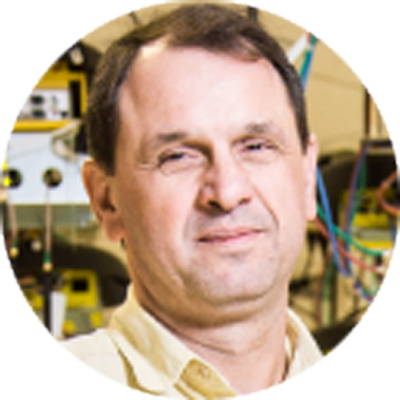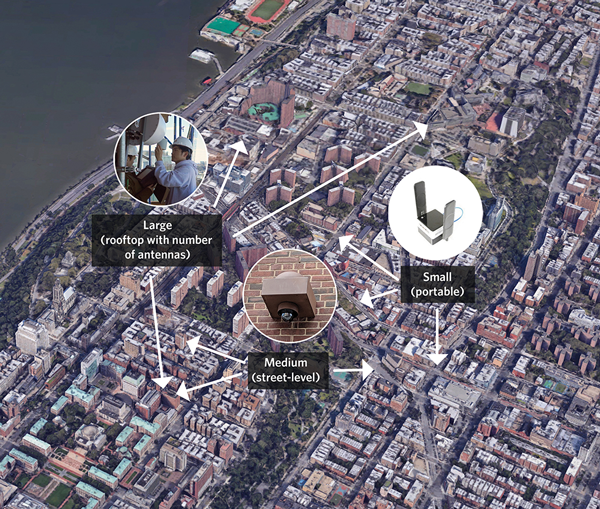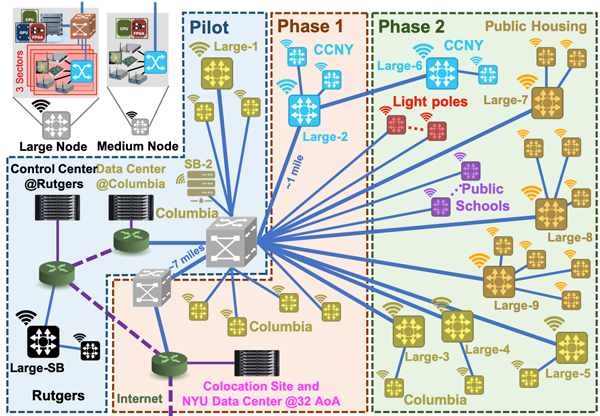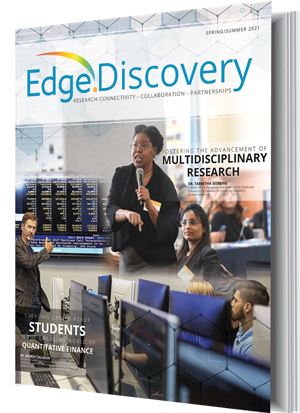Wireless network technology continues to rapidly evolve, making impressive strides since the 1880s when radio waves were first discovered. Today, we live in a world of high-speed data, broadband video, virtual reality, and the Internet of Things (IoT)—fueling an endless array of personal and business possibilities. To investigate and test these new technologies and the delivery of wireless, Rutgers University, Columbia University, and NYU have partnered with the National Science Foundation (NSF)— along with several organizations including New York City, City College New York (CCNY), University of Arizona, Silicon Harlem, and IBM—to design, develop, and deploy a city-scale advanced wireless testbed. The project, known as Cloud Enhanced Open Software Defined Mobile Wireless Testbed for City-Scale Deployment (COSMOS), aims to support real-world experimentation on next-generation wireless technologies and applications. The federated international testbed will enable experimental research on a wide range of optical, wireless, software-defined networking (SDN), inter-domain routing, and edge computing experiments at a global scale. Researchers will be able to run experiments remotely on the COSMOS testbed by logging into a web-based portal which will provide various facilities for experiment execution, measurements, and data collection.
Predecessor projects to COSMOS include the Open-Access Research Testbed for Next-Generation Wireless Networks (ORBIT) and Global Environment for Network Innovation (GENI). “Due to the ever-changing nature and scale of both the Internet and wireless technology, experimental exploration was important to help address the issues that were arising,” says Ivan Seskar, WINLAB Chief Technology Officer, COSMOS Program Director, Rutgers University. “With this mission in mind, the NSF created a consortium, called the Platforms for Advanced Wireless Research (PAWR), to build three to four city-scale advanced wireless research data beds with a goal of accelerating the innovation and commercialization of wireless technologies that are used by academic and industry researchers.”
Supporting Real-World Experimentation
In addition to its participation in the PAWR program, COSMOS, through its sister program COSM-IC, aims at the development of an international networking and wireless testbed by federating US research testbeds including COSMOS, ORBIT, FABRIC, and PEERING with experimental facilities in Ireland, Greece, Brazil, and Japan. “Since the goal is to advance wireless research and support real-world experimentation, advanced components are a necessity,” explains Seskar. “We approached Columbia and NYU and decided the best location for deployment of these tests would be outside. Normally, all the processing is happening very close to the antennae on a street-level or rooftop base station. Now, we are looking at pushing computing to the edge, as close as possible to the user and next to where the wireless signal gets into the infrastructure. With this setup, the optical transport becomes an integral part of the whole complexity and enables remote experimentation.”
The COSMOS testbed will be deployed in upper Manhattan, covering one square mile in West Harlem, consisting of 40-50 advanced software-defined radio nodes, along with fiber-optic front-haul and back-haul networks and edge and core cloud computing infrastructure. With a focus of bringing together research addressing critical technological, social, and civic challenges facing the world’s megacities, the densely populated location is ideal for pushing the latency and bandwidth limits and enabling the consortium to gather valuable insight. “The pilot phase of the project began in 2018, with the pilot rooftop deployment of one large node and two medium nodes at Columbia and one large and one medium node at the WINLAB facility,” says Seskar. “This placement helped determine if the design is functional and sound. Later in 2019, the Federal Communications Commission (FCC) established the Innovation Zone for the COSMOS deployment area. This beneficial milestone gave us access to several frequencies that are not typically allowed; enabling us to run experiments in frequency bands that are of national interest.”
Originally planned for March of last year, the deployment of the first phase of a testbed across Columbia and CCNY sites, along with a COSMOS control center at Rutgers, was delayed due to COVID-19. “Unfortunately, the pandemic was an immense challenge and pushed our timeline, but we are now officially in Phase 1 deployment. Thankfully, we have a vibrant research community that can use sandboxes to develop tools and proof of concept ‘software’ and conduct experiments with the indoor deployment of our equipment. We also have a Phase 2 planned, conditional on funding. This stage would be the deployment of a testbed across Columbia, CCNY, and NYC sites, which is essentially scaling up by adding more nodes and involving more city assets.”
Commitment to Outreach and Education
Silicon Harlem, a COSMOS partner, is an organization dedicated to transforming Harlem into a technology and innovation hub and has established a growing tech ecosystem in Upper Manhattan. The goal of Silicon Harlem is to develop an accessible broadband infrastructure, reproducible in urban markets that is affordable, fast, resilient, and smart and supports inclusive opportunities in STEM education. The organization operates as one of the interfaces between the COSMOS partners and the local community, aiming to integrate the testbed elements within the community and various smart city programs. “We’ve partnered with Silicon Harlem from day one,” shares Seskar. “We wanted to broaden our reach and make sure the larger community could benefit from this project. The focus was to develop educational materials and bring wireless research to the community lab.”
Through the partnership with Silicon Harlem, the consortium created the COSMOS Education Toolkit, a curriculum that blends the three disciplines of mathematics, science, and computer science and helps prepare students to be competitive in the workforce. Made up of seventy-five math labs, thirty-five science labs, and fifteen computer science labs, the toolkit offers lesson plans and worksheets for grades K-12 in a variety of subjects within each discipline. “In developing this toolkit, we recruited teachers from local high schools and middle schools to use our advanced wireless testbeds,” explains Seskar. “We received fabulous ideas from these educators and they helped transform the testbed-generated research into an innovative learning platform for students.”
Students are able to learn basic, as well as advanced STEM concepts, through running experiments either locally or on the COSMOS testbed. Especially for schools lacking resources, the COSMOS toolkit enables remote access for a larger number of students and provides hands-on learning that can help prepare learners for a successful future in STEM. “We have also expanded the program to include college students, called the Research Experience for Undergraduates (REU), and the program for local teachers, called the Research Experiences for Teachers (RET)” says Seskar. “REU allows students to participate in creative activities, including escape rooms and 5G EdTech challenges from Verizon. The summer program exposes students to research early in their academic careers and connects them with faculty—encouraging them to explore advanced degree options. Similarly, the RET program allows teachers to develop interesting experiments for their STEM curriculums.”
Improving Testbed Performance
The COSMOS platform’s technical architecture is designed to meet both quantitative and qualitative requirements associated with a fully programmable city-scale shared multiuser advanced wireless testbed facility. Radio nodes in COSMOS provide a mix of fully programmable SDRs for flexible wireless experimentation, as well as commercial hardware capable of supporting networking and applications research with currently available end-user devices.
One of the main goals of the COSMOS testbed is to take advantage of the educational and research experience of its academic and industry partners, like Edge, and transform the testbed-generated research into an innovative learning platform for students. “At the moment, we have campuses that are connecting over public internet, but we are trying to get dedicated secure connections between these institutions in order to improve testbed performance,” explains Seskar. “With a goal of getting a hundred gigabyte per second link to the 32 Avenue of the Americas (ALA) in New York City, we are currently deploying equipment at this point of presence. This connection will help open doors to mega research fiber points, international collaborations, and give us permanent connectivity to our COSMOS counterparts in Japan, Europe, and Brazil. Also, as members of FABRIC, we plan to have our node by the end of this year or early next year; helping to tie all of this together and further advance our project’s vision.”
One of the main goals of the COSMOS testbed is to take advantage of the educational and research experience of its academic and industry partners, like Edge, and transform the testbed-generated research into an innovative learning platform for students.
— Ivan Seskar

Deployment Plan
The COSMOS testbed will cover one square mile in West Harlem, with City College to the north, Columbia University’s Morningside Heights campus to the south, the Hudson River to the west, and Apollo Theater to the east. The envisioned deployment (composed of 3 stages outlined in the figure below) will include the following:
- 9 Large Sites
- 40 Medium sites
- Fiber optic connection from most sites
- 200 Small nodes ~Including vehicular and hand-held
- Fiber connection to NYU Data Center, Rutgers, GENI/I2
- Interaction with smart community & innovation initiatives (Gigabit center, etc.)





